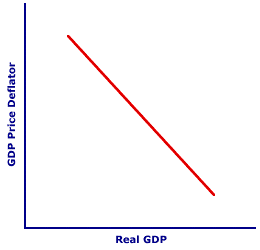
|
|
CAPACITY UTILIZATION RATE: The ratio of actual production by business sector factories and other productive establishments in the economy to the potential production of these establishments. This rate indicates if our economy's factories are being used as effectively and as fully as possible. Like the unemployment rate, the capacity utilization rate measures how close our economy is to full employment. And like unemployment, this rate moves up and down over the course of a business cycle. During expansions, the rate is near 85 percent (considered full employment), and during contractions, it tends to be in the 70 percent range. In addition to an overall rate, there are also separate rates for manufacturing, mining, and utility industries.
Visit the GLOSS*arama
|
|


|

|
                           INTEREST-RATE EFFECT: A change in aggregate expenditures on real production, especially those made by the household and business sectors, that results because a change in the price level alters the interest rate which then affects the cost of borrowing. This is one of three effects underlying the negative slope of the aggregate demand curve associated with a movement along the aggregate demand curve and a change in aggregate expenditures. The other two are real-balance effect and net-export effect. The interest-rate effect is one of three basic effects that indicates why aggregate expenditures are inversely related to the price level. The interest-rate effect works like this: A higher price level induces an increase in the interest rate which results in a decrease in borrowing used for consumption expenditures and investment expenditures. A lower price level has the opposite affect, inducing a decrease in the interest rate which triggers an increase in borrowing used for consumption expenditures and investment expenditures.| Along the Curve |  |
Before examining the details of the interest-rate effect, consider the specifics of what it does. A typical aggregate demand curve is presented in the exhibit to the right. The negative slope of the aggregate demand curve captures the inverse relation between the price level and aggregate expenditures on real production.When the price level changes, the interest-rate effect is activated, which is what then results in a change in aggregate expenditures and the movement long the aggregate demand curve. To illustrate this process, click the [Change Price Level] button. Most investment expenditures by the business sector and a fair amount of consumption expenditures by the household sector (especially for durable goods) are made with borrowed funds. Businesses typically borrow the funds needed for capital goods like factories and equipment. Households often borrow the funds used to buy durable goods like cars and furniture. The cost of borrowing these funds depends on the interest rate. A higher interest rate can add to the overall cost of the expenditure. A lower interest rate can reduce the overall cost of the expenditure. This means that changes in the interest rate can have a big impact on consumption and investment spending. The interest rate tends to increase and decrease as the price level increases and decreases. This means that a higher price level induces a higher interest rate which raises the cost of borrowing and discourages investment and consumption spending. A lower price level has the opposite result. Suppose, for example, that Duncan Thurly is primed and ready to buy a brand new OmniMotors XL GT 9000 Sports Coupe. Because this purchase will set him back over $20,000, which exceeds his available bank account balance, he plans to borrow the necessary funds. A four-year loan with a 10 percent interest rate, would result in monthly payments of $507, an expense he can handle. However, a boost in the price level that increases the interest rate on this loan to 12 percent results in monthly payments of $527. This extra $20 causes Duncan to pause and rethink this planned purchase. If he decides the extra expense is too much, then he has fallen victim to the interest-rate effect. Make note of the different role that interest rates play in a change in aggregate demand (a shift of the aggregate demand curve) and a change in aggregate expenditures (a movement along the aggregate demand curve). When interest rates change as a result of changes in the price level, the result is a change in aggregate expenditures and a movement along the aggregate demand curve. This is, in fact, the interest-rate effect. If interest rates change for any other reason (and there are many), the result is a change in aggregate demand and a shift of the aggregate demand curve. In this case, interest rates are an aggregate demand determinant.

Recommended Citation:INTEREST-RATE EFFECT, AmosWEB Encyclonomic WEB*pedia, http://www.AmosWEB.com, AmosWEB LLC, 2000-2024. [Accessed: May 14, 2024].
Check Out These Related Terms... | | | | | | |
Or For A Little Background... | | | | | | | | | | | | |
And For Further Study... | | | | | | | | | | | |
Search Again?
Back to the WEB*pedia
|



|

|
|
Much of the $15 million used by the United States to finance the Louisiana Purchase from France was borrowed from European banks.
|

|
|
"I don't know the key to success, but the key to failure is trying to please everybody. " -- Bill Cosby
|

|
NLS
National Longitudinal Survey
|

|
|
Tell us what you think about AmosWEB. Like what you see? Have suggestions for improvements? Let us know. Click the User Feedback link.
User Feedback
|


|


